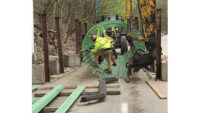Bridges made of uncoated weathering steel plate could be at risk for accelerated deterioration and potential collapse unless federal and state transportation authorities take immediate action to resolve outstanding maintenance issues, says a May 18 recommendation by the National Transportation Safety Board.
The agency action comes as it continues an investigation into the Jan. 28, 2022, collapse of the Fern Hollow Bridge in Pittsburgh, Pa. The 447-foot-long, three-span steel K-frame structure experienced a structural failure and fell approximately 100 ft into an underlying park ravine. Six vehicles were on or near the bridge when it collapsed, leaving four people injured.
NTSB says severe corrosion, deterioration and section loss on all four legs of the Fern Hollow Bridge resulted from blockages in the bridge drainage system that allowed water and debris to drain and accumulate on areas not intended to handle such flows. That, in turn, prevented the natural formation of a corrosion-resisting oxide coating, or patina, that typically helps protect uncoated steel elements.
A recently released NTSB Materials Laboratory report include photos and 3D laser scans of the deterioration on the bottoms of all four of the Fern Hollow Bridge's welded steel I-shaped legs, each of which rested atop reinforced concrete thrust blocks.
The agency further added that the presence of debris, dirt and leaves blocking the bridge drainage system were identified in inspections performed on behalf of the Pennsylvania Dept. of Transportation, but no regular maintenance had been performed to resolve the issues. Investigators found similar drainage and corrosion issues at other uncoated weathering steel bridges in Pennsylvania.
NTSB has not issued a final report on the probable cause of the collapse but cited “immediate implications for bridge safety nationwide” for this early recommendation, calling on agencies to review and follow up on inspection reports for uncoated weathering steel bridges. The agency has also asked the Federal Highway Administration to develop a process for U.S. bridge owners to perform necessary follow-up actions on such structures.
The Fern Hollow Bridge was replaced, on an accelerated schedule, with a $25.3-million new structure that opened in December, less than 11 months after the collapse.




